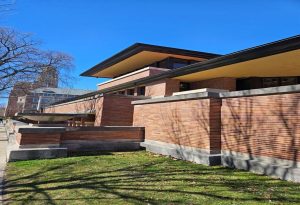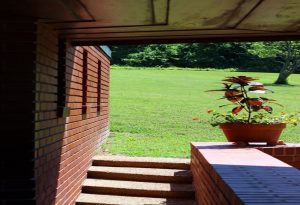Tour groups can see these iconic architectural structures up-close and experience the creativity of Frank Lloyd Wright
Explore the visionary genius of Frank Lloyd Wright with a journey through the heartland of America. Treat yourself to visiting a collection of his iconic houses, each a testament to his innovative approach to design and connection with nature. From the geometric wonder of the Robie House to the organic masterpiece of Samara, these architectural gems showcase Wright’s mastery of form and function.
For more travel tips and ideas for groups, be sure to Download the June edition of Leisure Group Travel and Subscribe for FREE

The Dana Thomas House was built between the years of 1902 and 1904 for Susan Lawrence Dana. The house serves as a classic example of the Wright Prairie School style of architecture. Photo by Patrick Emerson
Dana-Thomas House in Springfield, Illinois
The Dana Thomas House is an architectural spectacle. The house was built between the years of 1902 and 1904 for Susan Lawrence Dana. The house serves as a classic example of the Wright Prairie School style of architecture.
It is known for its clever approach, integrating organic elements, geometric forms and a feeling of spatial harmony and unity. Inside, the home embodies Wright’s characteristics of attention to detail and organic design principles. The collection encompasses more than 100 distinctive furniture pieces and 450 art glass windows, doors, and light fixtures all crafted by Wright himself. Today, it is a historic site and museum, offering guided tours exploring Wright’s architecture and the life of Susan Lawrence Dana.

The Frederick C. Robie House is considered one of the most important buildings in architectural history. Photo courtesy of David Arpi
Frederick C. Robie House, Chicago, Illinois
Located in Chicago, the Frederick C. Robie House is a historic landmark in the Hyde Park neighborhood. This house is designed by Wright and is considered one of the most important buildings in architectural history. The Robie House was commissioned by Frederick C. Robie, who wanted a home that reflected his forward-thinking preferences and provided a comfortable living space for his family.
Over the years, the Robie House has undergone various changes and renovations due to reasons like new owners, changing needs and preserving its architectural importance. Its open-plan layout features a single spacious room divided by a central chimney that is illuminated by the natural light of leaded glass windows and doors, along with glass panels with their colorful geometric patterns.
Today, the Robie House is a vital part of America’s cultural heritage, showcasing Frank Lloyd Wright’s strong vision for a new style of American architecture. The Robie House is currently open to the public as a museum operated by the Frank Lloyd Wright Trust.

Today, the Robie House is a vital part of America’s cultural heritage, showcasing Frank Lloyd Wright’s strong vision for a new style of American architecture. Photo courtesy of David Arpi.
Samara, The John E. Christian House, Lafayette, Indiana
This house was founded between 1954 and 1956 and was designed by Wright for Dr. John Christian and his wife Catherine to serve as their dream home. Inside, Samara demonstrates Wright’s innovative use of space and materials. The open floor plan, natural light, and strategic placement of windows and skylights create a sense of openness and connection to the outdoors.
Samara’s unique feature is its grid pattern on the concrete floor, which continues from inside the house to the outdoor terrace. This shows how Wright merges indoor and outdoor areas, emphasizing the unity of form and function within the design. And thanks to the efforts of the Christian family, John E. McCarthy, and the Christian Home Foundation, Samara has been well preserved and maintained over the years.

The Frank Lloyd Wright House in Ebsworth Park, Kirkwood, Missouri was designed and built in 1951. Photo by JazzChick.
The Frank Lloyd Wright House in Ebsworth Park, Kirkwood, Missouri
This house is an important architectural gem designed and built in 1951 upon the request of Russell Kraus and his wife Ruth. The design reflects Wright’s organic principles, which sought balance between the built environment and the natural landscape. A defining aspect of the house is its architectural structure, which revolves around a layout similar to a stretched-out rectangle, which contains a complicated floor plan made up of intersecting rectangles.
This house is open to the public for guided tours, offering visitors the opportunity to experience the ageless elegance of Wright’s architecture and innovative design in the peaceful atmosphere of Ebsworth Park.
Monona Terrace, Madison, Wisconsin
Monona Terrace is an architectural landmark on the shores of Lake Monona in Madison, Wisconsin. Wright’s architectural vision for the city of Madison was a curved gathering point connecting Lake Monona to the State Capitol; it was finally achieved in 1997 after 59 years of anticipation.
Monona Terrace includes a variety of patios and outdoor spaces that flow to the lakefront, offering striking views of Lake Monona and the Madison skyline. Inside, Monona Terrace has conference rooms, exhibition rooms, a large ballroom and a roof terrace. The interior reflects Wright’s values of natural architecture, as this landmark features open spaces, natural materials, and shapes inspired by nature. Today, Monona Terrace is a multi-use convention center and has become a well-known Madison landmark.
Laurent House, Rockford, Illinois
Located in Rockford, the Laurent House was completed in 1952 and was one of the few homes Wright has built that was specifically designed to be fully accessible to those who are physically disabled.
The Laurent House was owned by Kenneth and Phyllis Laurent, who contacted Wright in 1948 and asked him to design a house for Kenneth; in order to have a wheelchair-accessible home that was both functional and beautiful. A standout trait of the Laurent House is implementing continuous horizontal and vertical pathways throughout the design, allowing Kenneth Laurent to freely and comfortably move around.
This aspect of the design is incredible for its time, which is evidence to Wright’s forward-thinking approach to accessibility in construction. The Laurent House stands as one of the many proofs to the enduring legacy of Frank Lloyd Wright and his belief in the power of architecture to not only improve lives but change them.
Bernard and Fern Schwartz House, Two Rivers, Wisconsin
The Bernard and Fern Schwartz House, also known as “Still Bend,” is a landmark architectural design by Wright. Completed in 1939, it is located on the banks of the East Twin River in Two Rivers, Wisconsin. The Schwartz House is one of Wright’s Usonian designs.
Usonian homes sought to reflect Wright’s vision of natural architecture. This house in particular included the remarkable aspects of its “Cherokee Red” concrete floor, which exemplifies Wright’s Usonian design. As well as a pergola that connects the house to a small farm unit and the construction of a complex boathouse on the East Twin Rivers downstream from the house.
Over the years, the Schwartz House has been well preserved and restored, thanks to the efforts of its owners and preservation organizations. Open to the public for guided tours, it allows visitors to experience the timeless beauty and innovative design situated in Still Bend.
Cedar Rock State Park, Iowa
Located near Quasqueton in Northeast Iowa, Cedar Rock State Park is known for its natural beauty and architectural sense, especially for the presence of the Walter Residence, also known as the Lowell Walter House. Wright designed the house in Cedar Rock State Park, and it stands as a prime example of Wright’s ecological architecture.
Completed in 1950, the house features low ceilings, cantilevered ceilings and wide walls of windows. The interior showcases Wright’s signature attention to detail, large overhangs with curved edges reduce the sunlight and provide shade for the glass walls, and each room has clerestory windows or skylights. Cedar Rock State Park features hiking trails, picnic areas and scenic views of the Cedar River, allowing visitors to immerse themselves in the surrounding landscape.
Whether exploring the innovative design of the Walter Residence or enjoying the serenity of the area’s natural beauty, visitors to Cedar Rock are sure to be inspired by the balanced connection between architecture and nature.
Weltzeimer/Johnson House, Oberlin, Ohio
This structure was completed in 1948 and is one of Wright’s Usonian designs; its purpose is to provide affordable but architecturally important homes for middle-class families.
The clients for the Weltzheimer/Johnson house were Charles and Margaret Weltzheimer, who admired Wright’s work and asked him to design their family home. The house featured many masonry and fancy woodwork, like decorations made from colored croquet balls on the roof. Additionally, it has round decorations on the edges of the roof and curved cutouts in the high windows, which further enhance the organic feel of the design. The house is now owned by Oberlin College and serves as a museum and educational center, offering guided tours and public programs.
For more travel tips and ideas for groups, be sure to Download the June edition of Leisure Group Travel and Subscribe for FREE
By Cherissa Banag






